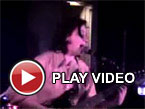BJ Nilsen, "The Invisible City"
 Using unrecognizably tweaked field recordings of cats, crows, bees, wasps, boat ramps, and dead trees, the ever-reliable BJ Nilsen has crafted yet another complex and desolately beautiful suite of droning ambiance that subtly crackles and buzzes with life. The Invisible City might be the first great headphone album of 2010.
Using unrecognizably tweaked field recordings of cats, crows, bees, wasps, boat ramps, and dead trees, the ever-reliable BJ Nilsen has crafted yet another complex and desolately beautiful suite of droning ambiance that subtly crackles and buzzes with life. The Invisible City might be the first great headphone album of 2010.
Sweden's BJ Nilsen has a surprisingly recognizable aesthetic for such an inherently faceless genre. Superficially, of course, all the central elements of contemporary electronic drone are here: a sustained and hypnotically shifting backbone, subterranean throbs, and a fluttering array of non-musical sounds dancing around it all. However, BJ is in a league by himself in regards to meticulousness, exactitude, and discipline. There is no clutter or bloat here, no laziness, and no attempt to use density to create an illusion of power and depth. Instead, Nilsen very starkly and crisply conveys exactly what he needs to and no more.
In lesser hands, that degree of calculation and artifice would probably result in a bloodless and clinical-sounding album. Actually, I suppose it is not completely unreasonable to describe this album as “clinical,” but it would be totally missing the point. The Invisible City is a deliberately cold, lonely, and futuristic-sounding album. Rather than an invisible city, it much more aptly evokes a haunting and Lynchian tableau of an utterly empty city at night, traffic lights endlessly flickering purposelessly and swaying in the gentle wind. Given the organic and nature-themed roots of much of the album’s source material, that is a pretty perverse place to wind up.
The liner notes provide a very interesting inventory of the sounds used for each individual track, which makes for an engrossing listening experience. Given that most of the field recordings are digitized into oblivion, I found it fascinating to try to figure out when exactly I was hearing an “amplified chair dragged across floor” or “dead trees leaning up against each other.” On the rare occasions when the source material is clearly recognizable, it is usually employed to disquieting effect (particularly the snowy footsteps in “Virtual Resistance”). The unnerving barrenness and alienation of the album creates a kind of vacuum that heightens the impact when anything recognizably human intrudes (and renders it vaguely sinister). Also, while there is generally not much overtly musical happening aside from occasional shimmering organ chords, vintage analog synthesizer fetishists will be thrilled to learn that Nilsen uses a subharchord for several tracks.
Those already familiar with BJ Nilsen’s work will not be surprised by much here, but they certainly will not be disappointed either. Nilsen has a very distinct and specific vision and he is steadily progressing and evolving within those narrow confines, but his trajectory is not likely to be obvious to casual listeners. The important thing is that BJ excels at what he does: the compositions themselves may be overtly minimal in nature, but the production transforms the base materials into something much deeper and more mesmerizing. This is layering at its most deft, as the glacially unfolding framework of the pieces houses a panning and warping hive of small-scale chaos. The Invisible City is a subtly mind-bending album of crystalline clarity and cold beauty.
Samples:



